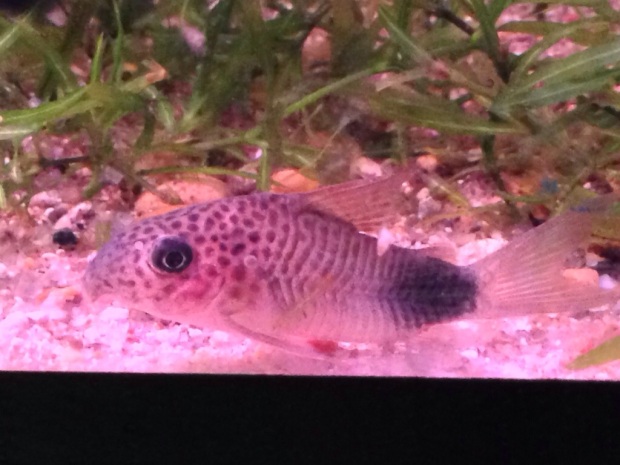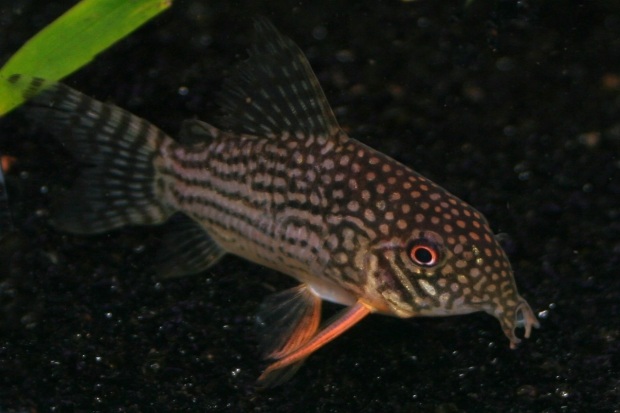Posts Tagged catfish
Albino Bristlenose 2013-D
Posted by lasaquatics in ancistrus, catfish, pleco types on November 28, 2013
This time I decided to wait until I knew for sure that the eggs the male was guarding were actually hatched before I took them. I noticed the eggs a full six days ago, and can only account for the delayed hatching by cooler water temperature… or it could just be that I haven’t noticed previous clutches right away. In an effort to save time, I decided to take a picture and count the fry in a freeze-frame…. much easier. I counted 166… largest spawn this year.
Corydoras similis
Posted by lasaquatics in catfish, corydoras, fish on November 21, 2013
Farlowella vittata
Posted by lasaquatics in catfish, fish, other catfish on November 9, 2013
Farlowella vittata is a twig catfish from Venezuela and Colombia. It lives among plants and roots along the banks of flowing waters. Males guard the eggs while they incubate, and other females often come along to add to the brood. After hatching, the young use up their yolk sac quickly and then have a most voracious appetite. The #1 cause of loss of Farlowella fry is starvation. They need very soft vegetable-based food, and lots of it to survive. We have had the best luck with Repashy foods, which comes as a powder and is mixed with water to make a gel that can be cut into blocks that the fry can graze from all day.
Corydoras sterbai
Posted by lasaquatics in catfish, corydoras, fish on November 7, 2013
One of my favorite little cories… I have a group of these bouncing around in a 20 long with some Limia vittata and a Mustard Spot Pleco.
Albino Bristlenose 2013-C
Posted by lasaquatics in ancistrus, catfish, fish, pleco types on November 6, 2013
This clutch is from a different male than the last two. Noticed him guarding on 11/4. Today I managed to catch him out of his cave and snatched it up!
Update: After stealing the cave, I decided to remove the eggs from it and let them hatch in the breeder trap. I’ve done this before, but these eggs were VERY adhesive, moreso than usual. Unfortunately, I damaged a few of them in the process and ended up losing the entire batch 😦 Since I have gotten the timing down and have found that collection is easiest immediately post-hatch, I will wait in the future until that moment, regardless of tankmates. Dad does a pretty good job of guarding eggs from snatchers without my help, so from now on, no more egg-stealing. Just frynapping.
Albino Bristlenose 2013-B
Posted by lasaquatics in ancistrus, catfish, fish, pleco types on November 4, 2013
The second batch of eggs were discovered on 10/28 and removed as they were hatching on 10/31 to a Marina breeder trap. There are about 125 babies in this clutch.
UPDATE: One week old is tough. At this point, the babies that either can’t or haven’t learned to eat have exhausted their yolk resources and start dying off due to starvation. The percentage is low, but it always bothers me to witness natural selection.
Albino Bristlenose 2013-A
Posted by lasaquatics in ancistrus, catfish, fish, pleco types on November 4, 2013
The bristlenose have finally started breeding again! On Oct 2 I found an egg clutch outside of the cave. I removed them to a trap, and unfortunately decided to remove an infertile one from the center of the clutch, damaging all but 11 of the others, which hatched on the 5th. My second faux pas was the addition of a tiny pair of scarlet badis. While their mouths are too tiny to eat the baby catfish, they delighted in carrying them around like a deflated soccer ball, sucking the yolk out. I was left with three, and they have grown very fast.



























Recent Comments